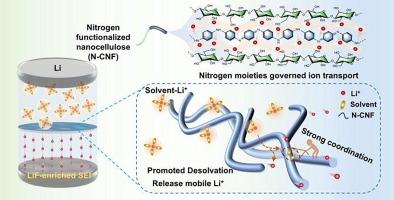天然羟基纤维素的氮功能化诱导了锂金属电池的富liff间期
IF 14.9
1区 化学
Q1 Energy
引用次数: 0
摘要
纤维素是最丰富和可再生的生物聚合物,由于其高纳米纤维结构和固有的亲锂性,为调节锂电沉积提供了一种可持续和经济的解决方案,以实现更安全的锂金属电池。在这项工作中,我们通过微量导电聚合物涂层将纤维素纳米纤维(CNFs)上的固有羟基转化为氮官能团,引入了基于界面工程的纤维素基分离器。实验和理论结果都表明,氮部分破坏了羟基纤维素内致密的氢键网络,使多种氮-锂相互作用增强了锂离子的运输。除了具有0.86的Li+转移数和1.1 mS cm−1的高离子电导率外,氮功能化CNF还有助于在锂金属表面形成均匀的电场和Li+浓度分布。这有利于形成富锂固体电解质界面,抑制锂枝晶生长。因此,Li||锂电池在电流密度为1ma cm - 2,固定容量为1mah cm - 2的情况下,可以稳定地镀/剥离循环约3000小时,同时保持15 mV的低过电位。我们的工作为推进可持续能源存储技术提供了对天然生物质表面功能化的宝贵见解。本文章由计算机程序翻译,如有差异,请以英文原文为准。

Nitrogen functionalization of natural hydroxyl cellulose induces a LiF-rich interphase for lithium metal batteries
Cellulose, the most abundant and renewable biopolymer, offers a sustainable and cost-effective solution for regulating lithium electrodeposition toward safer lithium metal batteries, thanks to its high nanofibrous structure and intrinsic lithiophilic property. In this work, we introduce interface-engineered cellulose-based separators by converting intrinsic hydroxyl groups on cellulose nanofibers (CNFs) to nitrogen functionalities through a trace conducting polymer coating. Both experimental and theoretical results reveal that the nitrogen moieties disrupt the compact hydrogen bond network within hydroxyl cellulose, enabling multiple nitrogen-lithium interactions that enhance lithium ion transport. In addition to an extraordinary Li+ transference number of 0.86 and a high ionic conductivity of 1.1 mS cm−1, the nitrogen-functionalized CNF contributes to a uniform electric field and Li+ concentration distribution across the lithium metal surface. This facilitates the formation of a LiF-rich solid electrolyte interface and suppresses Li dendrite growth. Consequently, Li||Li cells demonstrate stable plating/stripping cycles for approximately 3000 h at a current density of 1 mA cm−2 with a fixed capacity of 1 mAh cm−2, while maintaining a low overpotential of 15 mV. Our work provides valuable insights into the surface functionalization of natural biomass for advancing sustainable energy storage technologies.
求助全文
通过发布文献求助,成功后即可免费获取论文全文。
去求助
来源期刊

Journal of Energy Chemistry
CHEMISTRY, APPLIED-CHEMISTRY, PHYSICAL
CiteScore
19.10
自引率
8.40%
发文量
3631
审稿时长
15 days
期刊介绍:
The Journal of Energy Chemistry, the official publication of Science Press and the Dalian Institute of Chemical Physics, Chinese Academy of Sciences, serves as a platform for reporting creative research and innovative applications in energy chemistry. It mainly reports on creative researches and innovative applications of chemical conversions of fossil energy, carbon dioxide, electrochemical energy and hydrogen energy, as well as the conversions of biomass and solar energy related with chemical issues to promote academic exchanges in the field of energy chemistry and to accelerate the exploration, research and development of energy science and technologies.
This journal focuses on original research papers covering various topics within energy chemistry worldwide, including:
Optimized utilization of fossil energy
Hydrogen energy
Conversion and storage of electrochemical energy
Capture, storage, and chemical conversion of carbon dioxide
Materials and nanotechnologies for energy conversion and storage
Chemistry in biomass conversion
Chemistry in the utilization of solar energy
 求助内容:
求助内容: 应助结果提醒方式:
应助结果提醒方式:


